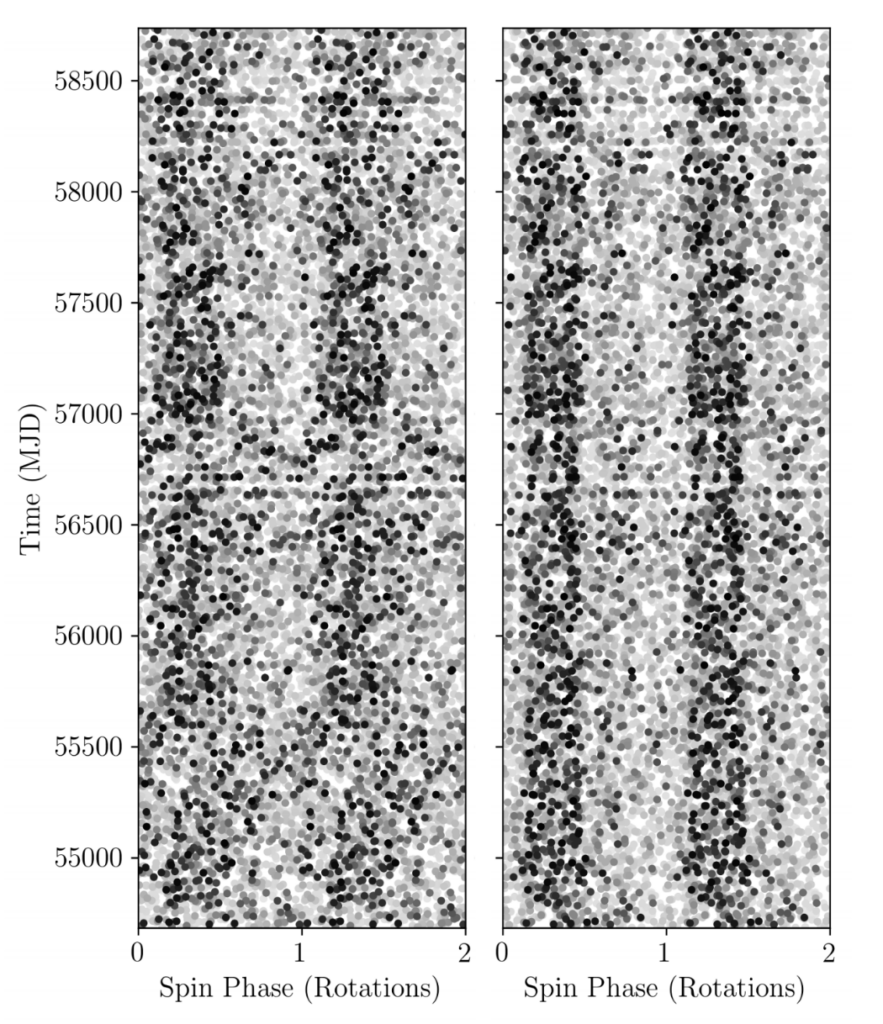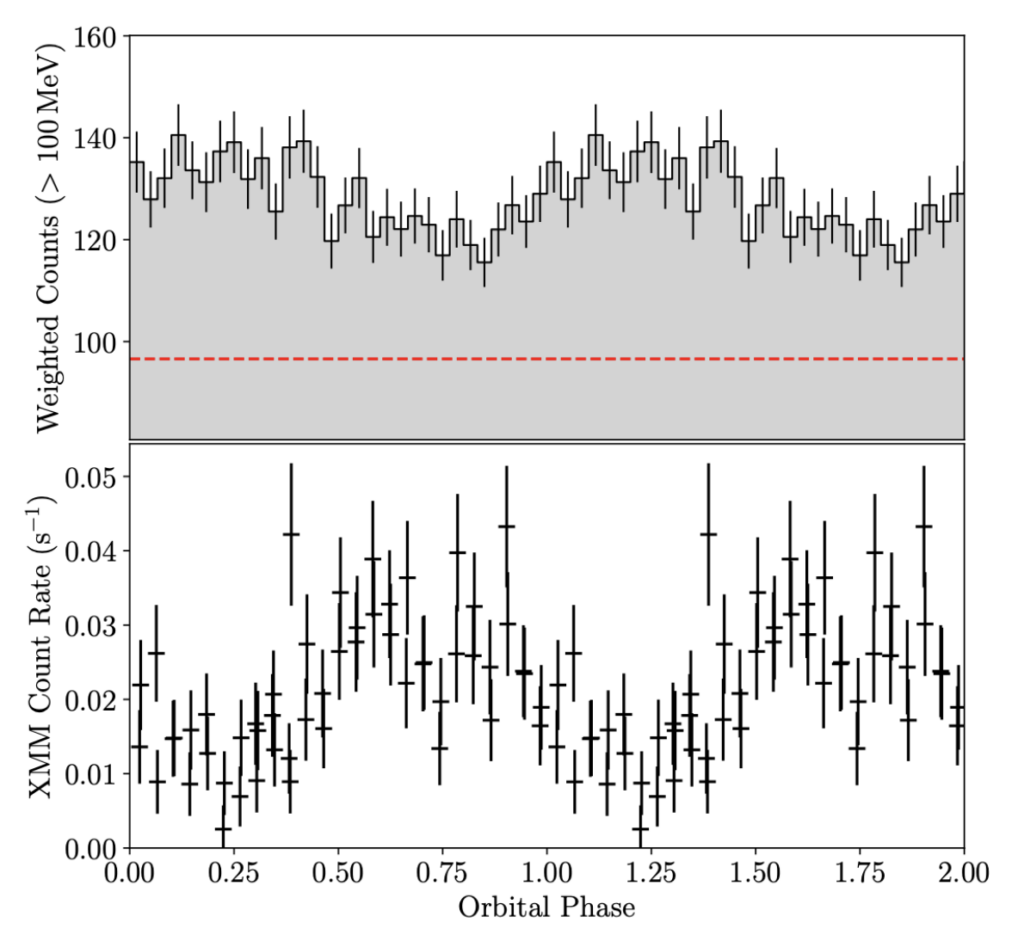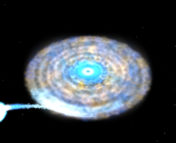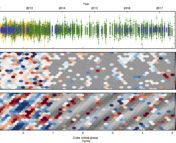Title: Einstein@Home Discovery of Gamma-ray Pulsations Confirms the Redback Nature of 3FGL J2039.6-5618
Authors: C. J. Clark, L. Nieder, G. Voisin, B. Allen, C. Aulbert, O. Behnke, R. P. Breton, C. Choquet, A. Corongiu, V. S. Dhillon, H. B. Eggenstein, H. Fehrmann, L. Guillemot, A. K. Harding, M. R. Kennedy, B. Machenschalk, T. R. Marsh, D. Mata Sánchez, R. P. Mignani, J. Stringer, Z. Wadiasingh, J. Wu
First Author’s Institution: Jodrell Bank Centre for Astrophysics, Department of Physics and Astronomy, The University of Manchester, M13 9PL, UK
Status: Submitted to MNRAS, open access on arXiv
Pulsars are rapidly rotating neutron stars that emit radio waves like a light house as they rotate. They come in many flavors, like millisecond pulsars (MSPs), pulsars that complete a rotation in less than 30 milliseconds, many of which belong to a family of “spider” pulsars. These spider pulsars are so named because they blow away or accrete the mass of their binary companion, similar to how some spiders kill their male partners. The two (or three) types of spider pulsars are known as black widows, which have accreted most of the mass from their binary companion star, and redbacks, which are currently accreting mass from their companions.
Spider MSPs are particularly hard to find when searching in the radio regime due to excess gas from their companions obscuring the pulsed emission. However, since the Fermi Gamma-Ray Space Telescope started publishing catalogs of unassociated gamma-ray sources, many have been found to be spider MSPs in follow up radio observations. But today’s paper has, for the first time, confirmed the redback MSP nature of the gamma-ray source 3FGL J2039.6−5618 by detecting gamma-ray pulses before finding the radio pulses!
A lesson in gamma-ray pulsar searching
Many MSPs have binary companions, which is what makes searching for their gamma-rays pulses so difficult. Unlike in radio searches, gamma-ray searches need to know the orbital parameters of the binary system extremely accurately. This is because there are so few gamma-ray photons emitted from MSPs that the Doppler shift from the orbital motion of the MSP and its companion will smear out the pulses and make them undetectable. So how did the authors of this paper find these gamma-ray pulses?
They used observations of 3FGL J2039.6−5618 that had been taken with the XMM-Newton X-ray Observatory , and optical observations with telescopes at the European Southern Observatory, GAIA, and the SOAR telescope, to constrain the orbit. These telescopes all found that 3FGL J2039.6−5618 had some kind of optical companion, most likely a main sequence star, and were able to trace out its orbital parameters. This suggested that this gamma-ray source was a redback MSP.
With orbital parameters in hand, the search for gamma-ray pulsations can begin. However, searching for these pulsations is extremely computational difficult, since many properties of the pulsar, such as its spin period, are still unknown. To help with the search, the authors utilized the Einstein@Home volunteer computing system. This system splits up the huge amount of computation into small chunks, and then uses idle volunteer computers to process these small chunks, greatly increasing the speed of the search (you can sign up here if you’re interested). The results of this search found a periodic signal in the gamma-ray data with a 2.65 ms period, and a minimum companion mass of 0.15 solar masses, or a mass 0.15 times that of the Sun, confirming that 3FGL J2039.6−5618 is indeed a redback MSP, now confirmed as PSR J2039-5617.
A lesson in gamma-ray pulsar timing

Once the pulsar has been found, its parameters can be refined even more by timing it, a process that minimizes the differences between the model of when the gamma-ray pulses are detected and when the model predicts they will be detected. This can lead to better constraints on the orbital parameters of PSR J2039-5617, which in turn allows us to learn more about its binary companion and the nature of redback systems. For gamma-ray pulsars, this is a complicated process that the authors complete through Markov Chain Monte Carlo (MCMC) sampling. In an MCMC, value of the parameter are randomly chosen according to a predefined distribution (here, based on the initial orbital and pulsar parameters). The likelihood that the randomly chosen values match the data is then computed, and new values are chosen until the most likely values for each parameter are found. While this is a computationally long process, the results are worthwhile, as shown by the improvement in the pulsar binary model in the right panel of Figure 1 compared to the left panel.
The timing model found using the gamma-ray detection can then be used to look for pulses in the X-ray emission of PSR J2039-5617, which were detected and are clearly shown with the gamma-ray pulses in Figure 2. From this modeling, the authors of today’s paper were able to learn more about PSR J2039-5617 than we have time to discuss here!

Class takeaways
There are many more unidentified gamma-ray sources from Fermi. If an X-ray or optical companion and orbit can be found, these sources can be searched for pulses and possibly confirmed as MSPs. While this may be just a small number of systems, they may be easier to confirm as pulsars by searching the gamma-rays than the radio observations. Additionally, the discovery of more redback MSPs will help us learn more about pulsar evolution and binary system formation. Timing these gamma-ray pulsars also improve models used to find pulses at other wavelengths. The model for PSR J2039-5617 was even used to detect radio pulses from it, as discussed in this companion paper. With the first confirmation of a pulsar through gamma-ray pulsations, the future looks bright, literally.





NICER-SEXTANT is now basically obsolete.
The methods presented in this paper just represent a new way to analyze old and incoming data, I don’t think they make the NICER/SEXTANT mission obsolete at all. While I’m not an expert in gamma-ray or X-ray pulsar timing, since Fermi was not designed initially to time pulsars, analysis of that data will be much more difficult than X-ray data collected by NICER. In addition, NICER has a very fast X-ray sampling rate, allowing them to time X-ray pulsars extremely precisely, and they already have some amazing results out because of that! As far as I know, NICER was not necessarily designed to discover new pulsars in the X-ray regime, but more to time already known pulsars more precisely than ever before, so I think the methods presented in this work are a nice compliment to work currently being done by the NICER/SEXTANT team.